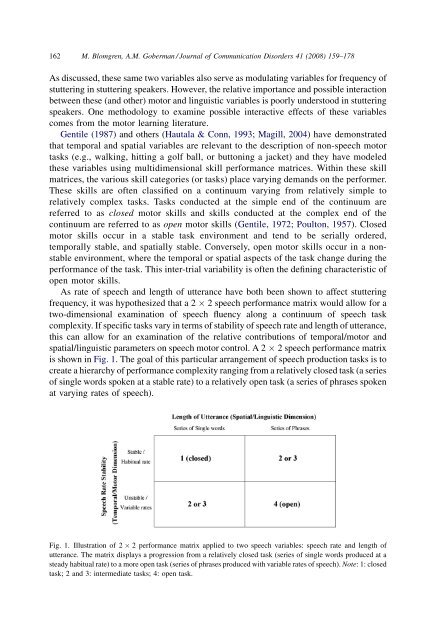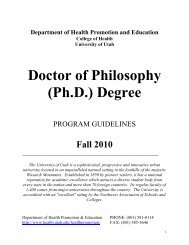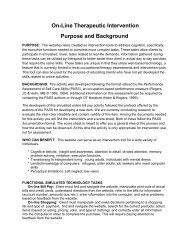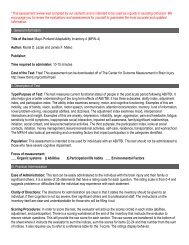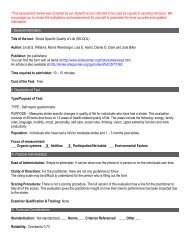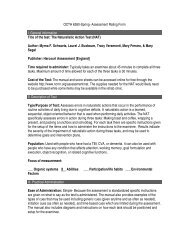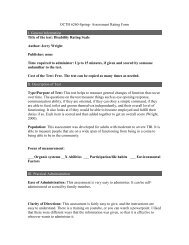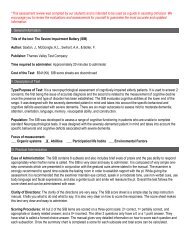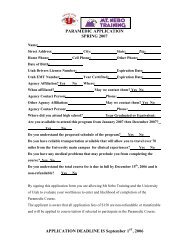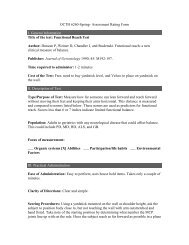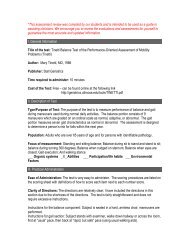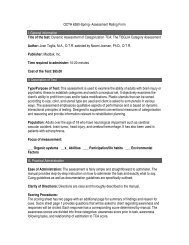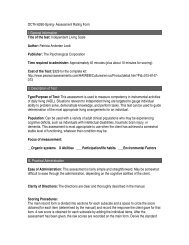Revisiting speech rate and utterance length ... - ResearchGate
Revisiting speech rate and utterance length ... - ResearchGate
Revisiting speech rate and utterance length ... - ResearchGate
You also want an ePaper? Increase the reach of your titles
YUMPU automatically turns print PDFs into web optimized ePapers that Google loves.
162M. Blomgren, A.M. Goberman / Journal of Communication Disorders 41 (2008) 159–178As discussed, these same two variables also serve as modulating variables for frequency ofstuttering in stuttering speakers. However, the relative importance <strong>and</strong> possible interactionbetween these (<strong>and</strong> other) motor <strong>and</strong> linguistic variables is poorly understood in stutteringspeakers. One methodology to examine possible interactive effects of these variablescomes from the motor learning literature.Gentile (1987) <strong>and</strong> others (Hautala & Conn, 1993; Magill, 2004) have demonst<strong>rate</strong>dthat temporal <strong>and</strong> spatial variables are relevant to the description of non-<strong>speech</strong> motortasks (e.g., walking, hitting a golf ball, or buttoning a jacket) <strong>and</strong> they have modeledthese variables using multidimensional skill performance matrices. Within these skillmatrices, the various skill categories (or tasks) place varying dem<strong>and</strong>s on the performer.These skills are often classified on a continuum varying from relatively simple torelatively complex tasks. Tasks conducted at the simple end of the continuum arereferred to as closed motor skills <strong>and</strong> skills conducted at the complex end of thecontinuum are referred to as open motor skills (Gentile, 1972; Poulton, 1957). Closedmotor skills occur in a stable task environment <strong>and</strong> tend to be serially ordered,temporally stable, <strong>and</strong> spatially stable. Conversely, open motor skills occur in a nonstableenvironment, where the temporal or spatial aspects of the task change during theperformance of the task. This inter-trial variability is often the defining characteristic ofopen motor skills.As <strong>rate</strong> of <strong>speech</strong> <strong>and</strong> <strong>length</strong> of <strong>utterance</strong> have both been shown to affect stutteringfrequency, it was hypothesized that a 2 2 <strong>speech</strong> performance matrix would allow for atwo-dimensional examination of <strong>speech</strong> fluency along a continuum of <strong>speech</strong> taskcomplexity. If specific tasks vary in terms of stability of <strong>speech</strong> <strong>rate</strong> <strong>and</strong> <strong>length</strong> of <strong>utterance</strong>,this can allow for an examination of the relative contributions of temporal/motor <strong>and</strong>spatial/linguistic parameters on <strong>speech</strong> motor control. A 2 2 <strong>speech</strong> performance matrixis shown in Fig. 1. The goal of this particular arrangement of <strong>speech</strong> production tasks is tocreate a hierarchy of performance complexity ranging from a relatively closed task (a seriesof single words spoken at a stable <strong>rate</strong>) to a relatively open task (a series of phrases spokenat varying <strong>rate</strong>s of <strong>speech</strong>).Fig. 1. Illustration of 2 2 performance matrix applied to two <strong>speech</strong> variables: <strong>speech</strong> <strong>rate</strong> <strong>and</strong> <strong>length</strong> of<strong>utterance</strong>. The matrix displays a progression from a relatively closed task (series of single words produced at asteady habitual <strong>rate</strong>) to a more open task (series of phrases produced with variable <strong>rate</strong>s of <strong>speech</strong>). Note: 1: closedtask; 2 <strong>and</strong> 3: intermediate tasks; 4: open task.


